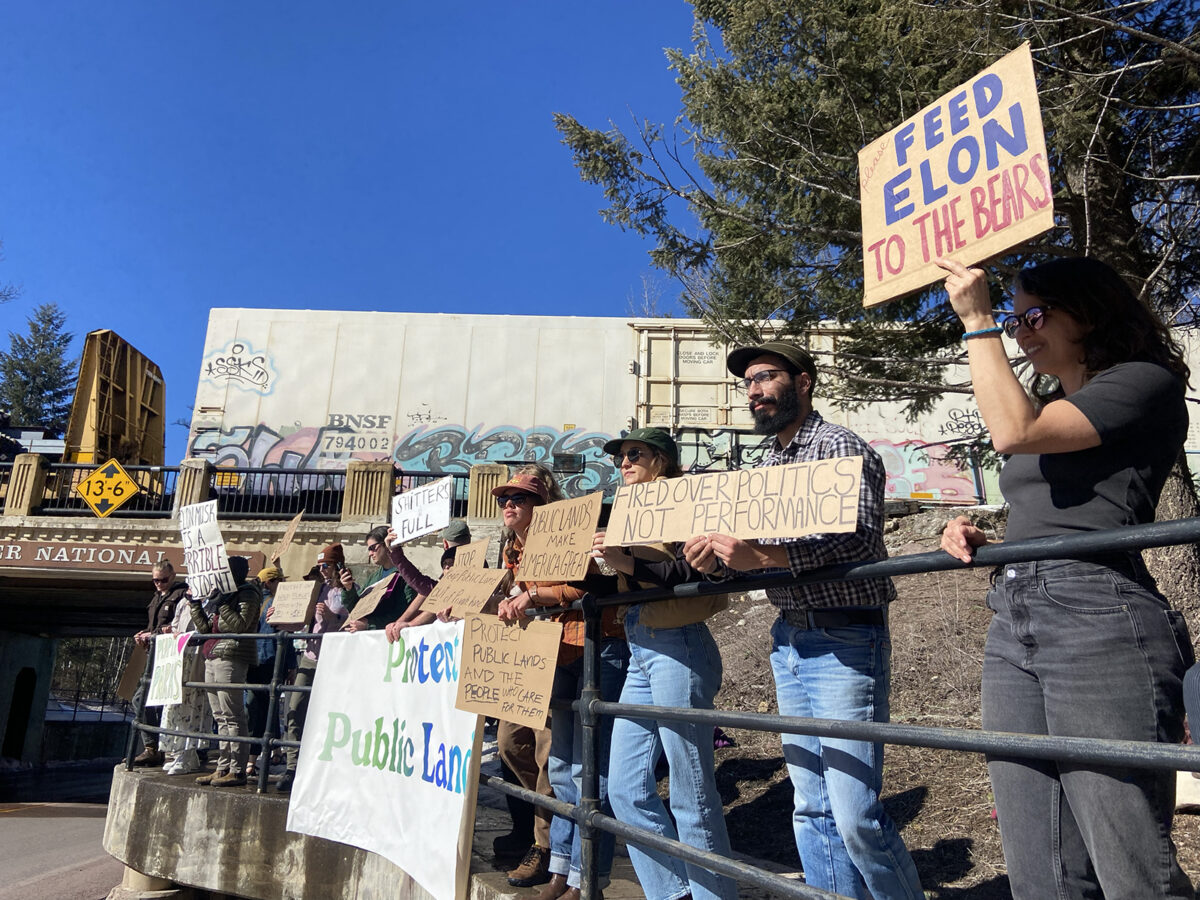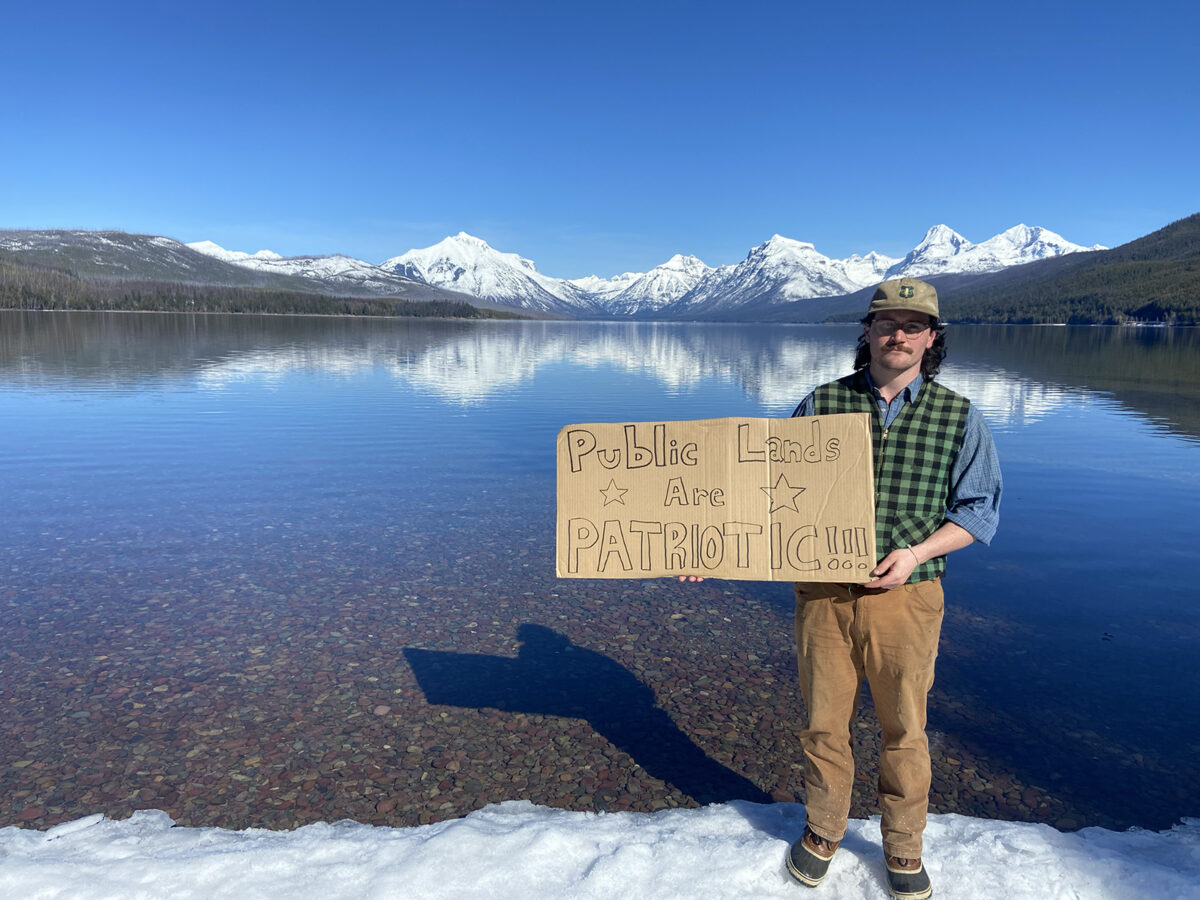‘It’s Not About the Paycheck, It’s About the People’: Fired Workers Rally at Glacier National Park
Ranging from recently laid-off federal workers to public land advocates, more than 120 people turned out in West Glacier Saturday as a series of demonstrations unfolded across the U.S. to protest the Trump administration's federal workforce cuts
By Tristan Scott
The outset of March dawned blue and bright for Jon Zanett, who set out from his Columbia Falls home for a Saturday morning trail run at Cedar Flats, a nearby trail system in development on the Flathead National Forest. His two Siberian husky dogs joined him. By noon, he’d dropped off the dogs and picked up his kids for a trip to Glacier National Park.
But it wasn’t a typical park trip.
Holding signs declaring their support for national parks and forests, Zanett and his two young children joined about 120 other public lands advocates to protest the Trump administration’s purge of federal employees and to voice concerns about the future of America’s parks and forests.
“This is our backyard,” Zanett said. “I’m raising my kids in these open spaces.”
Standing by his father’s side at the West Glacier entrance, Noah Zanett, 12, said his passion for the park reached new heights last summer, when he and his father climbed Piegan Mountain and attempted Mount Siyeh, but stopped short of the summit.
“We’re going to go to the top next year,” Noah said.
“Assuming the park is open,” his dad added.
Organized through social media and by word of mouth, the demonstrations unfolded on March 1 at 433 national park units across the U.S. to protest the mass layoffs shaking multiple federal agencies, including the National Park Service and the U.S. Forest Service. Roughly 1,000 National Park Service employees and 3,400 Forest Service employees were terminated on Feb. 14. An earlier executive order forced the National Park Service to rescind more than 2,000 seasonal and permanent job offers while directing a hiring freeze on all federal civilian positions.
The government has since reportedly lifted its freeze on seasonal employee hires, but no new positions have been posted to USAJobs.gov, the federal government’s official employment site. Even if the open positions do materialize, there’s no guarantee they can be filled before seasonal operations begin this spring, administrators said.

Sarah Lundstrum, the Glacier program manager for the National Parks Conservation Association, who attended the rally with her dog, Walter, questioned the logic of the whipsaw policymaking, which is ostensibly aimed at making the federal government more efficient. Instead, it has ignited panic and confusion across the agency as it seeks to onboard thousands of seasonal employees, including about 350 workers in Glacier. Those jobs include park rangers, trail and maintenance crews, entrance station staff, and plow operators, who are now less than a month away from beginning the onerous task of clearing a winter’s worth of snow from the famed Going-to-the-Sun Road.
“There are currently no positions posted for Glacier Park even though the National Park Service apparently had approval to hire seasonals over a week ago. Those jobs aren’t posted, so even with that hiring opportunity we are kind of slow walking it out, which increases the chances of it impacting park operations,” she said, explaining that the park begins the hiring process in early winter. “I mean, it’s March 1. Plowing on Going-to-the-Sun Road starts April 1. Will we have the folks we need? I don’t know. It’s so hard to say what actual impacts will be. But there will be impacts.”
The blunt force of the impacts hit with greater velocity on the Flathead and Kootenai national forests, where dozens of employees were terminated, including many with years of experience. While most of the fired employees were in probationary periods, the cuts didn’t only affect newly hired workers. Many were longer-tenured employees whose job status shifted last year when an agency-wide hiring conversion slotted temporary seasonal workers into permanent positions.
When PJ Benson received his termination notice two weeks ago, he was preparing for his fourth season working on the trail crew at Schafer Meadows, a backcountry ranger station in the Spotted Bear Ranger District of the Bob Marshall Wilderness Area. Along with Benson’s position, his entire work crew lost their jobs; the trails program at Big Prairie Ranger Station, the other backcountry outpost on Spotted Bear, was also decimated.
The two dozen workers who spend their summers living at the stations are responsible for maintaining more than 1,100 miles of trails across a remote but popular segment of the Bob Marshall Wilderness totaling nearly 1 million acres. Performing the job requires a specialized skillset as workers rely on hand tools like cross-cut saws, Pulaskis, loppers, and axes in a setting where motorized and mechanized tools are prohibited.
“We clear the trails, we maintain the bathrooms, we maintain wilderness airstrips, interact with rafters, pilots outfitters — all these folks who use our public lands,” Benson said Saturday. “And the skillset that we are trained in is pretty niche. We’re packing with mules, we’re using crosscuts, we’re using axes. I wouldn’t be surprised if those ranger stations are completely shut down this summer. So I think people are going to be sorely disappointed because it’s going to get dire pretty quick.”

Holding a cardboard sign emblazoned with block letters reading “Public Lands Are Patriotic,” Benson stood over the mirrored surface of Lake McDonald as motorists passing through Apgar Village leaned on their horns in support. Imagining the millions of people who visit the region’s national parks, forests and wilderness areas every year, Benson said the layoff wounded him deeply, not because of the lost pay, but because it signaled an exodus of the civil servants who steward the landscape.
“It’s not about the paycheck, it’s about the people. It’s about our passion for public lands and access,” he said. “If it was about the paycheck none of us would be doing this. I made around $17 an hour. And we’re doing hard manual labor. Anyone who things that we’re lazy government employees can come join us on the trail for the day.”
“I don’t think people are going to start feeling it until it’s too late,” Benson added.
In a typical summer, volunteer organizations like the Bob Marshall Wilderness Foundation and the Back Country Horsemen of Montana play a support role in the Bob, clearing and retreading trail, and training volunteers to use cross-cut saws and manual hand tools to perform the work. But the organizations rely on experienced trail workers to lead the crews, and there’s neither enough time nor a robust enough volunteer workforce to fill the void the layoffs have inflicted on the landscape.
“We are already stretched thin, and we depend on this community of Forest Service employees,” said Francie Hammer, the trail crew lead for the Bob Marshall Wilderness Foundation. “Everyone who cares about public lands will suffer with this loss.”